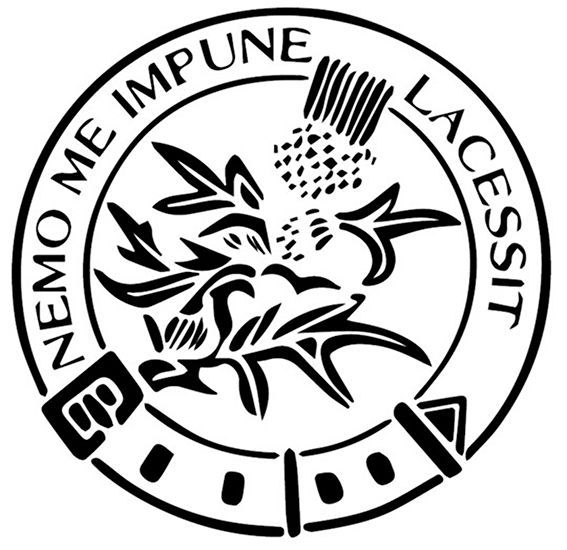
Thistle Squadron
This stone was originally part of the pedestal of the Jan Olieslagers statue. The statue, which used to stand where the entrance and exit of the car park is now, was later moved to the beginning of the Luchthavenlei.
The Thistle was the emblem of the 1st Squadron in which Jan Olieslagers was enlisted during the First World War.
Period until the end of the First World War
Even before the outbreak of the First World War, it was decided to set up a “Compagnie des Aviateurs”. Immediately two squadrons were assembled, the first of which, commanded by Lt. Demanet, was stationed at Brasschaat. The aircraft that were assigned were built in Antwerp by the Bollekens brothers: Farman Jero MF16 biplanes built according to French plans. The second Squadron was based at Kiewit near Hasselt.
In July 1913, the "blue" squadron, as it was now called, got its baptism of fire when it took part in major army manoeuvres between Sambre and Meuse. After the outbreak of WWI, the Squadrons swapped airfields several times (even the Wellington Racetrack in Ostend served as a base!) and the first, or blue, squadron was found in 1916 on the airfield of De Moeren, where French aircraft were also stationed. The latter all had an emblem painted on the fuselage, which prompted our compatriot, André De Meulemeester from Bruges, to develop the idea of designing a squadron logo for Belgian aircraft as well.
An initial idea to use a mosquito as a badge was rejected from above. The choice to take the Scottish Thistle was well received. Because of its thorns, the Thistle can be regarded as the symbol of defence and protection. The motto “nemo me impune lacessit” which means “no one shall challenge me with impunity” was also adopted and placed across the top of the fuselage just behind the cockpit. The first design was only poor and was redrawn after the arrival of the later Belgian ace of aces (most victories in the air with the Belgians) Willy Coppens. This second draft was considered final. Until recently, we could still find this design on many of our F-16s. After a first reorganisation in the spring of 1918, the first squadron was renamed the ninth squadron, but it kept its traditions. It is also around this time that the Thistles divided themselves into "Flights".
The nacelle of Jan Olieslagers' Flight was painted green and white, that of De Meulemeester red, that of De Neef red and white and that of Gallez white. At the end of the First World War, the pilots of the Thistles had 53 official victories on their record. Jan Olieslagers, whose Sopwith Camel replica you can admire here in the museum, took on six enemy aircraft. Unconfirmed - victories witnessed by no one but the pilot himself - would add 17 more to his record.
Period until the beginning of WWII
After the First World War, our Thistles moved to the airfield of St.-Agatha-Berchem near Brussels and shortly afterwards to Schaffen near Diest. The squadron remained here until 10 May 1940, the day the Germans again invaded our country. In 1929, reorganizations took place again. The new designation was now 2/I/2 which means 2nd squadron of the I-group of the 2nd aviation regiment. From this period, the aircraft in the squadron will also be standardised.
Where shortly after WWI they still flew with a colourful mixed collection of Spad XIII, Hanriot HD.1, Fokker D.VII (originating from the Germans), Sopwith Camel and Morane-Saulnier A-1 Parasol, the Thistles now flew on 1 or 2 types of aircraft. The squadron received new French-made Nieuport-Delage D29 C.Is, built in Belgium by SABCA. Czech-made Avia BH-21s were delivered in 1929, to be replaced in turn by English Fairy Fireflys from 1931. The first truly modern aircraft, the Hawker Hurricanes, were delivered from May 1939. These famous English fighters were a great advancement for our pilots and it would be with these aircraft that the Thistles would await the Germans. On 21 October 1939, the squadron received a visit from Queen Elisabeth. The next visit, on 10 May 1940, were German Heinkel HE-111s. They damaged and destroyed 9 of the 11 available Hurricanes. The next day the last two were destroyed and the Thistle Squadron ceased to exist…
Period 1947 to the present.
On November 11, 1947, a squadron was again established that inherited the traditions of the Thistles. It became the 351st squadron of the 161st wing. The squadron code painted on the aircraft was 3R- followed by an individual letter. The squadron colour is black. Shortly after the change from Military Aviation to the Belgian Air Force, new numbers were also given to the wings and their squadrons (with the exception of the Belgian squadrons 349 and 350 established within the Royal Air Force during WWII). At the insistence of the veteran Baron Willy Coppens de Houthulst, the 351st was brought back to its original numbering, namely 1st Squadron. The 161st wing became the 2nd Wing. This 2nd Wing, which was equipped with English Spitfires MK XIV, is still based at Florennes.
1951 was a very important year for our Thistles because the switch to airplanes powered by a jet engine started that summer. The Gloster Meteor was already in service with the fighter squadrons of the 1st wing in Beauvechain (Bevekom), but with the attack squadrons or, in air force jargon, fighter-bombers, to which the 1st Squadron belonged, it was waiting for the American F-84 E and G Thunderjets. Barely in use, in August 1955 they already switched to the arrow wing-equipped F-84F Thunderstreak. It was with this F-84F that the sound wall was broken for the first time by the Belgian Air Force. In 1971, the Thistle Squadron temporarily left Florennes and its 2nd Wing to become part of the 3rd Wing at Bierset base near Liège. A little later, the Thunderstreaks were exchanged for new, French-made Mirage 5s assembled in Belgium. With this delta wing, as the triangular wings are called, more than twice the speed of sound could be achieved… 18 years later, the Mirages were exchanged for the infamous F-16s and the 1st Squadron could return home, to the 2nd Wing at Florennes base.
Stampe en Vertongen Museum vzw
Antwerp International Airport
Bus 3
B-2100 Antwerp-Deurne
Belgium
O.N. BE0447.236.613
RPR Antwerp
email: stampe@skynet.be
www.stampe.be
Opening hours individual visits
- Mon - Fri
- Closed
- Sat - Sun
- -
Closed on Easter Sunday and during August, December and January
Useful links
All rights reserved | Stampe en Vertongen Museum vzw






